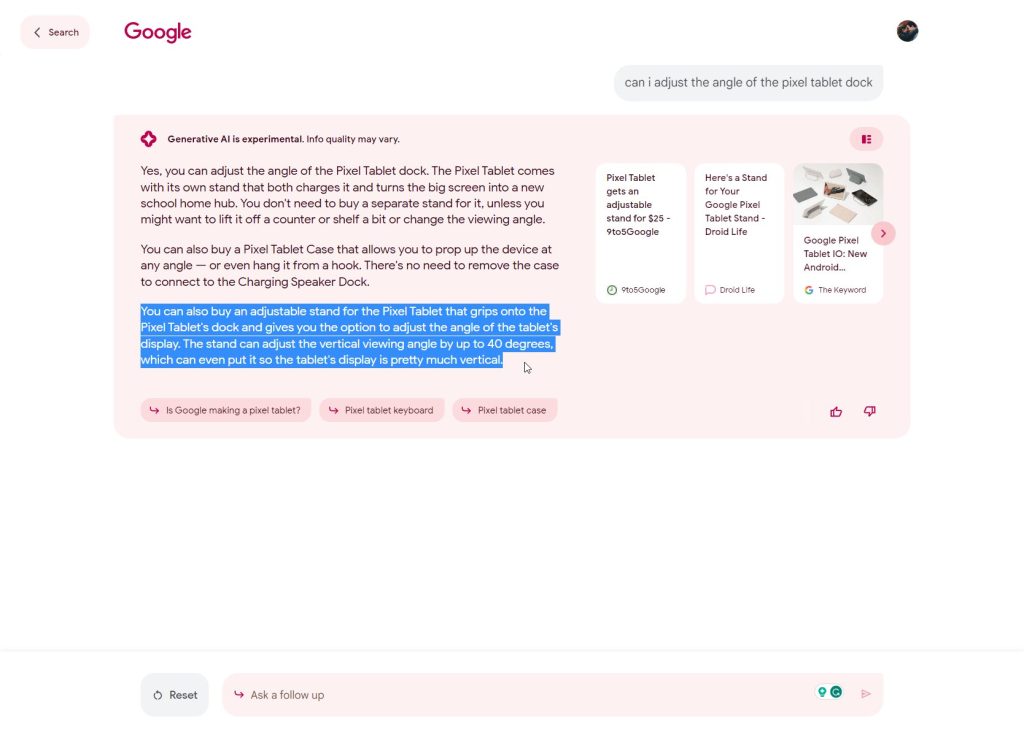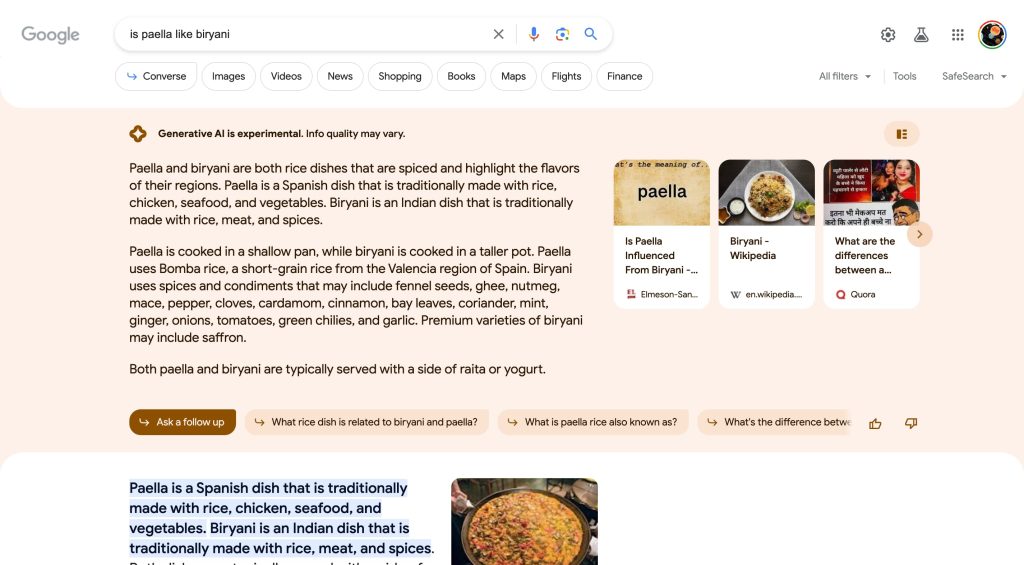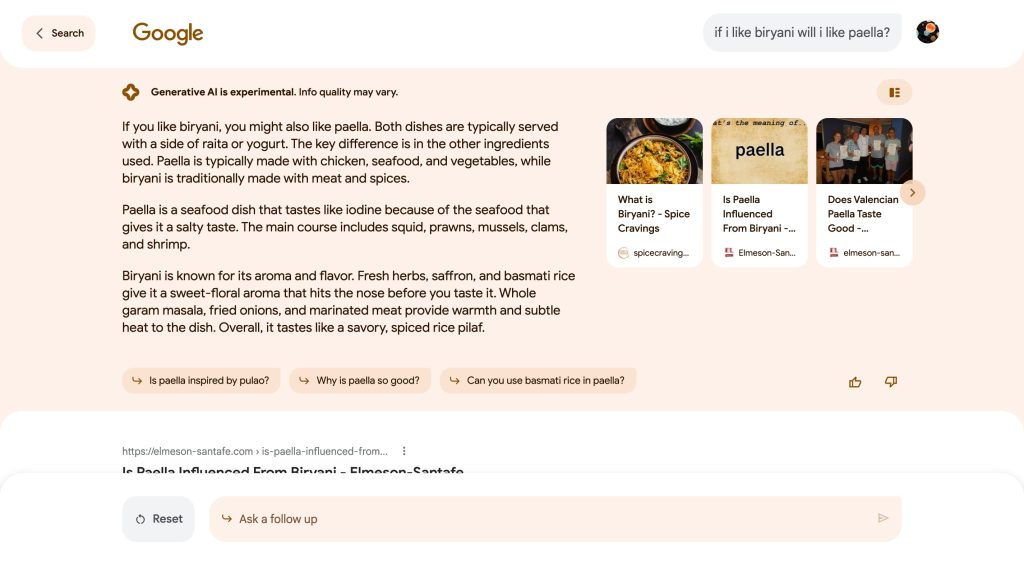
In using the future of Google for the past few days, I’ve had some takeaways about the AI-powered Search Generative Experience (SGE). It’s early days for SGE, but I think the fundamentals are set in stone: Most people for most queries will find generative Search useful.
All encompassing
Fundamentally, your entry point into Google Search with SGE has not changed: You still enter a question into a box.
On the results page, the 10 blue links you’re familiar with are no longer directly underneath the search field. Rather, there’s a new section with a colorful background that takes a few noticeable seconds to load.
Google starts by noting that “Generative AI is experimental. Info quality may vary.” before giving you a response that’s either a few sentences or a list. Where Google got this information from is listed next to the generated response (on desktop) or at the bottom (mobile) as a carousel.
Most answers can be expanded to see how and where this information came from. Here, you will get a sentence-by-sentence or item-by-item breakdown that notes where each line originated from.
A carousel at the very bottom shows suggested follow-up questions with the ability to ask your own. That will launch conversation mode, with all queries also featuring a “Converse” button – which probably could be branded “Bard” for its familiarity – underneath the main Search bar.
This might sound like a painfully obvious observation, but SGE – by design – is an all encompassing experience that you don’t have to leave to get your answer.
Those first few sentences, and all those that come after, are presented in the same way. Something that I found incredibly surprising after just a few days of usage is how I like the fact that the sentences are visually displayed in a consistent and direct manner without different page formats. It feels premium and curated to have information presented in a visually uniform manner.
[Aside: I very much do not like the black text for links that Google is testing with SGE. The company tells us that it might change before the final launch.]


The scary consequences of being sufficient
With the queries I’ve tested over the past few days, I have not felt the need to read the Feature Snippet, Knowledge Panels, or the 10 blue links. And that is frightening, but not surprising.
The trajectory of technology is one of simplicity. Looking at Google Search, you first had links and then Google started showing answers to questions that it could directly. Be it the weather, facts, or direct quotes from websites.
Most of the time, especially on mobile, people want direct answers. You can’t blame them for this whatsoever. It’s just plain convenient to read a few sentences rather than open links most of the time.
That is why I think SGE and its AI-powered snapshots will be something that most people will like and find to be good enough for most questions. So good that they don’t have to click the source links, even as we found that Google is sometimes directly regurgitating the source.
When asked about the example we encountered, Google had the following to say:
We’re putting websites front and center in SGE, and the goal is to highlight websites and drive attention to content from across the web. Generative responses are corroborated by sources from the web, and when a portion of a snapshot briefly includes content from a specific source, we will prominently highlight that source in the snapshot. You can expand to see how the links apply to each part of the snapshot. SGE is an experimental experience in Search Labs, and it will evolve over time as we learn what is most helpful for people.
Google spokesperson
People lead increasingly busy lives and SGE feels like a curated service that analyzes the entire web for them and returns just the answer without the cruft of modern day websites, or the repeated scrolling.
When they do have further questions, SGE is right there for them with the conversational mode that supports follow-up questions. After asking, Google remembers the context of the original query and carries that over.
[Tangent: Some tech innovations are so obvious that they’re taken for granted immediately and forgotten after launch. One example of that for me is in the early days of voice assistants. After hearing the answer to “What’s the weather in San Francisco?” you can ask “How about tomorrow?” without having to repeat the name of the city. Preserving context, to me, was a big sign that technology was finally adapting to us.]
I’ve only been using SGE for a few days, but I think most people will prefer chatting with Google rather than clicking on links when they have follow-up questions so that they can continue getting that white-gloved experience of having the work done for them.
Maybe not Google Search anymore
For me, the traditional definition of a search engine is of a tool that directs people to other websites. Again, with Knowledge Panels and Featured Snippets, that hasn’t been true of Google in a long time, but SGE feels like it takes things a step further.
The act of synthesizing a response from all the information in the world changes Google’s role. It’s no longer highlighting information or directing you to sites, it has just become the answer in a way that I think people over time will find indistinguishable from Google just being the source of information.
As generative AI takes hold, “Google” could stop being a verb about finding information. Rather, it will change into the idea that Google is where you go to get the definite answer. It changes from you seeking, even if it’s just to the first link, to expecting that you can just read the generated answer below the search bar and be done with it.
When you search a question into SGE, it takes a few seconds for the answer to be synthesized. Before that happens, the UI looks pretty much the same as before, with the Featured Snippet and 10 blue links visible. Once an answer is generated, the old UI is literally pushed down in what seems like a perfect metaphor for where Google is going.
FTC: We use income earning auto affiliate links. More.













Comments